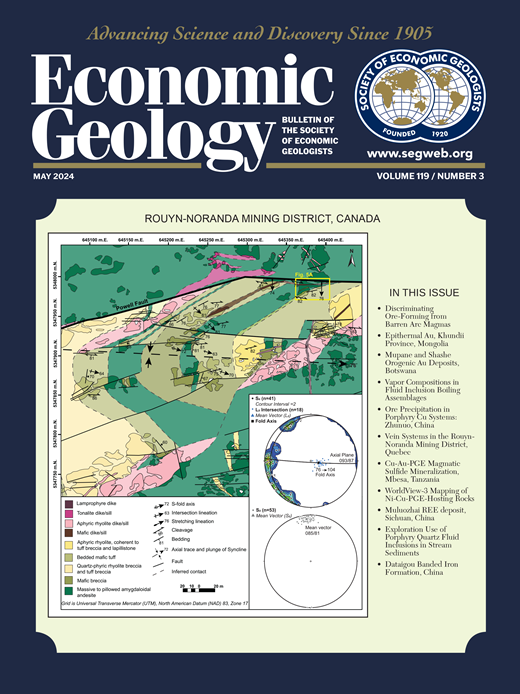Decoupling of Sulfur Isotope Signatures from Platinum Group Elements in Komatiite-Hosted Ore Systems: Evidence from the Mount Keith MKD5 Ni-(Co-Cu) Deposit, Western Australia
IF 4.9
1区 地球科学
Q1 GEOCHEMISTRY & GEOPHYSICS
引用次数: 1
Abstract
Abstract Komatiites require external sulfur from country rocks to generate immiscible sulfide liquid, which concentrates metals to form economic nickel sulfide deposits. Although signatures related to mass-independent fractionation of S isotopes (MIF-S, denoted as Δ33S) may identify external S sources, their values may not be directly indicative of the S reservoirs that were tapped during the ore-forming process, because of dilution by S exchange between assimilated sulfide xenomelt and komatiite silicate melt. To quantify this process and be confident that MIF-S can be effectively used to track S sources in magmatic systems, we investigated the effect of silicate melt-sulfide liquid batch equilibration, using the proxy of silicate/sulfide mass ratio, or R factor, on the resulting MIF-S signatures of pentlandite-rich ore from the Mount Keith MKD5 nickel sulfide deposit, Agnew-Wiluna greenstone belt, Western Australia. We carried out in situ multiple S isotope and platinum group element (PGE) analyses on pentlandite from a well-characterized drill core through the deposit. The variability in Pd tenor and MIF-S signature suggests that these are decoupled during batch equilibration and that the latter is not controlled by metal-derived R factor. Rather, the observed spread of MIF-S signatures implies that the sulfide xenomelt was initially heterogeneous and that chemical equilibration of S isotopes is incomplete as opposed to that of PGEs in a komatiite melt. Consequently, magmatic sulfides, which formed in the hottest, most dynamic, and likely fastest equilibrating magmatic systems on Earth, may still preserve their initial MIF-S isotope compositions, reflecting the range of crustal S reservoirs that were available upon komatiite emplacement.科马铁矿含矿系统中铂族元素硫同位素特征的解耦:来自西澳大利亚Mount Keith MKD5 Ni-(Co-Cu)矿床的证据
科马地岩需要外部岩石中的硫才能生成不混溶的硫化物液体,这种硫化物液体将金属富集,形成经济的硫化镍矿床。虽然与S同位素的质量无关分馏(MIF-S,表示为Δ33S)相关的特征可以识别外部S源,但它们的值可能不能直接指示成矿过程中开采的S储层,因为同化的硫化物xenommelt和komatiite硅酸盐熔体之间的S交换稀释了S。为了量化这一过程,并确信MIF-S可以有效地用于跟踪岩浆系统中的S源,我们研究了硅酸盐熔融-硫化物液体间歇平衡的影响,使用硅酸盐/硫化物质量比(R因子)作为代理,对来自西澳大利亚Agnew-Wiluna绿岩带Mount Keith MKD5硫化镍矿床的富镍褐铁矿矿石的MIF-S特征进行了研究。我们对该矿床特征良好的钻取岩心中的镍黄铁矿进行了原位多S同位素和铂族元素(PGE)分析。Pd音调和MIF-S特征的可变性表明,它们在批平衡过程中解耦,而后者不受金属衍生R因子的控制。相反,观察到的MIF-S特征的分布表明,硫化物xenommelt最初是异质的,并且S同位素的化学平衡是不完整的,而不是科马铁矿熔体中的PGEs。因此,岩浆硫化物,形成于地球上最热、最活跃、可能最快平衡的岩浆系统中,可能仍然保留了它们最初的MIF-S同位素组成,反映了在科马铁矿就位后可用的地壳S储集层的范围。
本文章由计算机程序翻译,如有差异,请以英文原文为准。
求助全文
约1分钟内获得全文
求助全文
来源期刊

Economic Geology
地学-地球化学与地球物理
CiteScore
10.00
自引率
6.90%
发文量
120
审稿时长
6 months
期刊介绍:
The journal, now published semi-quarterly, was first published in 1905 by the Economic Geology Publishing Company (PUBCO), a not-for-profit company established for the purpose of publishing a periodical devoted to economic geology. On the founding of SEG in 1920, a cooperative arrangement between PUBCO and SEG made the journal the official organ of the Society, and PUBCO agreed to carry the Society''s name on the front cover under the heading "Bulletin of the Society of Economic Geologists". PUBCO and SEG continued to operate as cooperating but separate entities until 2001, when the Board of Directors of PUBCO and the Council of SEG, by unanimous consent, approved a formal agreement of merger. The former activities of the PUBCO Board of Directors are now carried out by a Publications Board, a new self-governing unit within SEG.
 求助内容:
求助内容: 应助结果提醒方式:
应助结果提醒方式:


